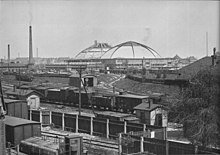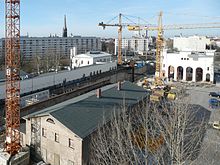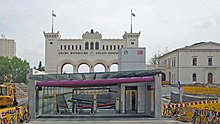Leipzig Bavarian train station
| Leipzig Bayer Bf | |
|---|---|
|
The Bavarian train station around 1890
|
|
| Data | |
| Design |
Tunnel station head station (formerly) |
| Platform tracks | 2 |
| abbreviation | LLB |
| IBNR | 8012184 |
| Price range | 5 |
| opening | 1842 (terminus) 2013 (tunnel station) |
| Conveyance | 2001 (terminus) |
| Profile on Bahnhof.de | Leipzig_Bayerischer_Bahnhof |
| location | |
| City / municipality | Leipzig |
| country | Saxony |
| Country | Germany |
| Coordinates | 51 ° 19 '45 " N , 12 ° 22' 54" E |
| Railway lines | |
|
|
| Railway stations and stops in Saxony | |
The Bayerischer Bahnhof in Leipzig is located southeast of Leipzig's old town, south of Bayrischer Platz . The station was put into operation in 1842 by the Saxon-Bavarian Railway Compagnie and until its closure in 2001 was considered to be the oldest operating terminus in Germany (other sources speak of the oldest surviving terminus in the world). The tracks were completely demolished as part of the construction work for the Leipzig City Tunnel . It was replaced by an underground station that went into operation in December 2013.
The city-side head building (" Portikus ") of the former station concourse is under state protection as a monument to the history of traffic .
history
The Bavarian train station was built between 1841 and 1844 based on designs by Leipzig architect CAE Pötzsch and served as the starting point for the Leipzig – Hof railway line . It was opened on September 18, 1842, still unfinished, together with the first section to Altenburg . The reception building was not completed until September 19, 1844. West of the reception building, a bowling team built a restaurant in a similar style in 1845 and then sold it to an innkeeper who called it Siebenmannhaus .
On September 7, 1883, the Bavarian train station was connected to the local transport network of the city of Leipzig with a tram route , on which horse-drawn trams ran until 1897 , then electric trams .
Since October 1, 1912, the express and express trains have been running on the Leipzig Hbf – Leipzig-Connewitz line to the new central station, since then the Bavarian station has only served local and freight traffic and special trade fair trains. Especially for these, there were routes approved for passenger trains on the Leipziger Güterring .
According to plans by the Düsseldorf architect Emil Fahrenkamp from 1939, the station was to give way to a boulevard. The station was partially destroyed in the air raids on Leipzig on December 4, 1943 and February 20, 1944. While the portico and the buildings on the west side were largely preserved, the wooden station hall burned down; Most of the buildings on the east side also had to be demolished later. The grounds of the Siebenmännerhaus, where Lenin spoke in 1914, were not built on again during the GDR era.
In 1952 the depot was closed.
Since October 2, 1961, the tracks in the station, with the exception of the loading tracks, had been spanned with catenary. Around 1970 it was to be shut down completely and without replacement. In 1972 general cargo handling was relocated to the Magdeburg-Thuringian train station. Around 1978 plans arose to convert parts of the station into a permanent display facility. In a further step, a museum railway was to be set up between the train station and the site of the technical fair , which was to be operated during fair times and other special occasions. In the mid-1980s, the signal boxes were renewed using the existing high-rise buildings, and the shape signals on the platform tracks were retained for monument protection reasons . The portico was renovated in 1991 in accordance with a listed building.
The buildings on the west side, the original departure side, were renovated in May 1999 and have been used by the Gasthaus und Gose brewery Bayerischer Bahnhof since July 19, 2000 .
After the cessation of scheduled railway operations in June 2001, the site was unused for a few years and the first construction work did not begin until 2005. The railway systems have been completely removed, for more see under construction of the underground station .
From the beginning of 2011 to May 2012, the exterior of the portico was renovated again. Among other things, it was found that the building fabric was ailing than expected, so that completion was delayed several times. On May 25, 2012, the completion of the renovation was celebrated with a ceremony.
At the end of September 2019, the city of Leipzig, in cooperation with the housing company Buwog and Leipziger Stadtbau AG, announced that up to 1,600 apartments, three schools and around 330 daycare places are to be built on the former site of the terminus station. In addition, according to official information, an area of approx. 150,000 m² for offices and commercial use will be created on the site. The year 2027 is given as the end date of the construction project.
description
The portico , which is perpendicular to the tracks and which also formed the northern gable of the station hall and through whose four gate-like arches, each led a track , is still preserved today . A bell on the portico announced the departure of the trains. It is now in the Dresden Transport Museum . The four tracks merged north of the station in a turntable on which the locomotives could be turned. The middle two tracks had no platform. They were only used to return the locomotive to the other end of the train after turning on the turntable or to park trains.
Above the four portals, an inscription the width of the building refers to the former owner of the station. Originally it was the Saxon-Bavarian Railway Company .
The inscription was later changed, initially to
later in
and again in the renovation after reunification
In the middle of the lettering is a large clock. The portico is flanked on both sides by a tower with a square floor plan.
To the south, the no longer preserved 95 m long station hall was directly connected to the portico, the wooden roof structure of which was supported by twenty twelve meter high oak columns. There were two-storey longitudinal buildings on both sides of the hall: the arrival in the east, the departure in the west. An administration building in the north and in the south were attached to these longitudinal buildings. The northern, two-storey administrative buildings were connected to the portico by a three-arched gallery, which was set back towards the north facade.
Construction of the underground station
On June 10, 2001, rail operations at the Bavarian station (most recently with regional trains to Altenburg and Zwickau) were completely stopped. However, two years passed before construction of the Leipzig City Tunnel began . The existing systems were to be used for supplying the construction site, so signal box 3 on Richard-Lehmann-Strasse was retained for the time being. This did not happen, however, the tunnel construction site was served exclusively by truck. In the course of the construction of the city tunnel to the main train station , an underground island platform, Leipzig Bayer Bf , was built at the level of the former station hall by December 2013 . Also on the site of the former Bavarian train station, the Leipzig MDR station was built with two outside platforms on Semmelweisstraße at the level of the former depot , directly below the still existing locomotive shed. The new stations are not stops, but parts of the station and, like the entire city tunnel, part of the Leipzig Hbf station; the entrance signals are on the access routes from the former Tabakmühle junction or from Gaschwitz train station.
In order to create space for the construction of the city tunnel, the 20 meter high, 30 meter wide and six meter deep and 2800 tonne portico was moved 30 meters to the east on April 10, 2006 with the help of special slide bearings . The foundation was encased with concrete. After it had hardened, HEB steel girders were inserted through the foundation, on which the structure was lifted and moved. After completion of the shell of the City-Tunnel-Station at Bayerischer Bahnhof, the portico was moved back to its old location on October 30, 2009.
The city tunnel went into operation on December 15, 2013.
gastronomy
The Gasthaus & Gosebrauerei Bayerischer Bahnhof opened on July 19, 2000. It consists of a restaurant with Bavarian cuisine, as well as its own brewery, which brews various beer specialties in addition to the original Leipziger Gose . The restaurant consists of an à la carte area, a beer garden and function rooms and is designed to cater for up to 1160 people. It is operated by the Weißenburg brewer Thomas Schneider, who owns the small Schneider brewery with the "Zur Kanne" brewery in his hometown .
literature
- The Saxon-Bavarian train station in Leipzig . In: Illustrirte Zeitung . No. 16 . J. J. Weber, Leipzig October 14, 1843, p. 244-246 ( books.google.de ).
- Rolf Bayer, Gerd Sobek: The Bavarian train station in Leipzig . Origin, development and future of the world's oldest terminus. 1st edition. transpress VEB publishing house for transport, Berlin 1985.
- Manfred Berger: The Bavarian train station in Leipzig. Report on attempts to save him. In: Modellisenbahner. 39 (1990) 7, pp. 8-11.
- Roger lattice man: The Bavarian train station in Leipzig . In: Horst J. Obermayer (Ed.): Lok-Magazin . No. 130 . Franckh'sche Verlagshandlung, W. Keller & Co. , 1985, ISSN 0458-1822 , p. 4-17 .
- Transport Museum Leipzig . In: Alfred B. Gottwaldt (ed.): Lok magazine . No. 118 . Franckh'sche Verlagshandlung W. Keller & Co., 1983, ISSN 0458-1822 , p. 8-9 .
- Working group site management / site supervision City-Tunnel Leipzig (ed.): City-Tunnel Leipzig: Chronicle of the development of a Saxon traffic project . Strom & Strom, 2009, ISBN 978-3-939516-07-1 , p. 34-41 .
Web links
- History and historical pictures of the Bayerischer Bahnhof
- Information and pictures on the construction progress of the underground station (City-Tunnel Leipzig)
- Detailed description with pictures and videos of the Portukus shift in 2006 and 2009
- Official City Tunnel website
- Delivery to the Bavarian train station in Leipzig in the holdings of the Reich Railway Directorate Halle in the Saxony-Anhalt State Archives, Dessau department
Individual evidence
- ^ Leipzig: Oldest terminus is being renovated. In: Die Bundesbahn , 6/1983, p. 405 f.
- ^ A b Rolf Bayer, Gerd Sobek: The Bayerische Bahnhof in Leipzig . 1985, p. 126, 148-151 .
- ↑ The history of the Bavarian train station at www.bayerischer-bahnhof.de
- ↑ Citytunnel Leipzig - Portikus at the Bayerischer Bahnhof shines in new splendor. LVZ online , May 25, 2012, accessed on May 18, 2017 .
- ^ Urban area Bayerischer Bahnhof Leipzig »The information portal. Retrieved October 23, 2019 .
- ↑ Frank Eritt: portico shift at the Bayerischer Bahnhof 2009 . citytunnelleipzig.info , accessed September 9, 2009.
- ↑ gose.de
- ↑ bayerischer-bahnhof.de









